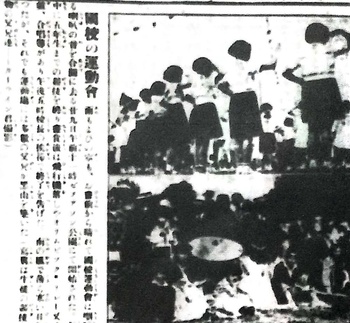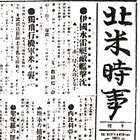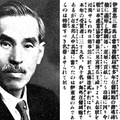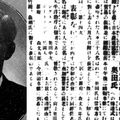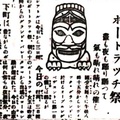PROBLEMS OF TEXTBOOKS
One of the North American Times1 articles (Feb. 13, 1919 issue) talks about the discuission about the textbooks that should be used at the Seattle Japanese school.
There has been discussion on the need for textbook editing and compilation at the Seattle Japanese School. After a series of meetings and discussions by the educational affairs committee, and with the opinions of teachers at Japanese schools in different parts of Washington State as well as those of board members of the schools, a final decision was made to carry out the work collectively.
A meeting was held two days ago at the Jitsugyo Club (business club) and was expected to be attended by representatives from 15 schools in the state, but the actual attendants were from eight schools: Uemura (Spokane), Makiyama, Yamashita (Kent), Sumiyoshi (Winslow), Yamagiwa (Bellevue), Kinoshita, Oikawa (Fife), Tomosada (Aurora), Kakihara (Port Bradley), and Kumagai (Green Lake).
Representing the Seattle Japanese School were Principal Takabatake and six teachers: Chairperson of the Maintainance Committee Ito, Director of Educational Affairs Akiyoshi, and four members of the Educational Affairs department, Amano, Hashiguchi, Nagai and Tsuchiya. They held a roundtable discussion with Ito as moderator.
Akiyoshi explained that the West Coast committee has been looking into this matter since last year. Given the fact that schools in San Francisco and Los Angeles have already started working on the editing, people in each region are recognizing the need to either modify or newly edit their textbooks — and that the time has now come to take such action.
Principal Takabatake pointed out that some parts of the textbooks designated by the Japanese Ministry of Education are inappropriate and that some parts are too difficult for children to comprehend.
The next agenda item was to seek opinions of the six schools that did not attend the meeting and make a final decision by majority vote of the Japanese School Educational Affairs Committee. They also decided to ask for donations from the community for the editing expenses and to hold an annual roundtable meeting of people involved in the state’s Japanese schools starting this year.
The article showed the push to change the textbooks used in the U.S. from the ones used in Japan to new textbooks to promote Americanization. According to some sources, the new textbook series comprised eight volumes, Nihongo dokuhon (Japanese Reader), published during 1920 to 1927. Mr. Takabatake was presumably the chief editor of this project and the series was called the “Takabatake Edition.”
KOTARO TAKABATAKE, PRINCIPAL OF SEATTLE JAPANESE SCHOOL
The column “One Person a Day” (Feb. 18, 1919 issue) introduced Kotaro Takabatake, the principal of the Seattle Japanese School.
The chairperson of Fukuoka Kenjinkai and principal of the Japanese school gives the impression of someone with an artistically-free mind, as he is well-skilled in writing haiku poems, using Tanei as his pen name. He worked as a writer for The North American Times. He has written for the Asahi newspaper as well and currently writes for Taihoku Nippo.
He job-hopped in the news publishing industry yet has stuck to being a schoolteacher for a long time, as in the expression, “10 years, 1 day” (meaning to spend a long time without much change, as if to repeat the same day for 10 years). Being a man of few words, he doesn’t seem to know how to get to things quickly, but he is the exact type that gets things done in a smart way.
Takabatake served as principal of the Seattle Japanese Language School from 1909 to 1928 and greatly contributed to the operation of West Coast Japanese schools.
A GROUP OF SCHOOL PRINCIPALS FROM TOKYO VISIT SEATTLE
Several articles in 1919 features a group of 16 Japanese elementary school principals observing schools in the United States.
Arriving in San Francisco last October by Shunyo-maru with the delegates of Yamashina jitsugyo, 16 school principals (names listed) with the exception of Moriya, the leader, arrived in Seattle yesterday via St. Paul as a US observation group of principals of Tokyo elementary schools. Their aim was to observe schools in various parts of the east and study the educational system.
Led by the principal of Seattle Japanese School Takabatake and by Nagajima, the secretary of the Nihonjin-kai (Japanese Association), they visited the main school first yesterday on January 9. In a receptive mood, they observed classes.
In the afternoon, they visited the educational department of the Consulate as well as other well-known public elementary schools.
“Notes on What Was Observed”
It used to be that a group of elementary school principals from Japan would skip the Northwest when prioritizing their destinations because they would not have any knowledge of Seattle. In Japan, few people know about Seattle, but having seen the unexpected progress and growth of peer schools here, they seemed quite surprised this time.
Everything they see is new to them. It’s very pleasant to see Japanese children in the US in great shape and full of energy, which is something they cannot overlook. In contrast with students in Japan, who look pale and are in poor health, children in America growing up in great condition must deeply touch their hearts and provoke envy. Seeing the hardships that people experienced and the challenges they overcame to make the education of their future generations possible, those who work in the same field in Japan must feel sympathetic to what their peers in America are going through. We also have great respect for all of you peers (Japanese principals) who work hard for your fellow Japanese residents and for the nation of Japan.
“What We’ve Seen and Heard”
Principals from Japan were amazed by the heating facilities in the United States. In Japan, they only have (charcoal) braziers; teachers would tell students, ‘You can’t be true grownups if you can’t put up with this cold,’ although the teachers themselves are shivering, too.
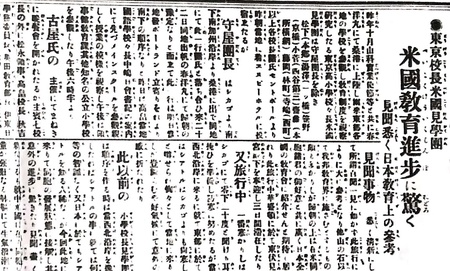
Sources that reported on this visit from Japan revealed that the observation group, after visiting the Seattle Japanese School, was surprised to learn that the building of the schoolhouse was made possible by donations from many and that the school was fully equipped with supplies such as desks and stools. Tokunosuke Miyazaki from ‘The North American Times’ visited the hotel where the group was staying and handed the “Hokubei Nenkan” (“North American Annual”) to everyone, all of whom welcomed it.
SEATTLE JAPANESE SCHOOL AFTER 1934
There are many articles on the thriving of the Japanese school, beginning in 1934 when the Nisei generation age-wave, which began about 1910 and peaked about 1920, crested through the school. (A graph of the wave is in “A second look at the Ireizo,” napost.com).
“Night Class at Japanese School” (Dec. 1, 1934 issue)
Japanese School to start a night class from 8 to 9 pm once a week for high school graduates.
“Teachers Meetup” (Oct. 17, 1935 issue)
The 14th Northwestern teachers meetup will be held on November 14th in Seattle.
“Appreciating the Work of Patrol Officers at Japanese School” (Dec. 22, 1938 issue)
A gathering was held to appreciate the work of patrol officers who help ensure traffic safety for the 1,200 students of the Seattle Japanese School who commute to school in the evening in the cold winter.
There are several artciles about Japanese School graduation ceremonies. The below are summaries of some articles.
“Japanese School Graduation Ceremony” (Mar. 26, 1938 issue)
A graduation ceremony for the Japanese School will be held tomorrow on the 27th in the Nippon-Kan (Japanese Hall). There will be 129 graduates from the elementary department and one graduate from the junior high department. Among all graduates, the names of 25 honors students (eight boys and 17 girls) were posted.
“End-of-Year Ceremony and Graduation Ceremony of Japanese School” (Mar. 25, 1939 issue)
This year there were 137 graduates from the elementary department and seven graduates from the junior high department. Two female students from the junior high department received the 10-year perfect attendance award.
“The 32nd Graduation Ceremony” (Mar. 30, 1940 issue)
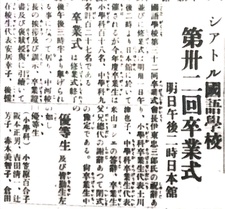 “The 32nd Graduation Ceremony at Seattle Japanese School” (The North American Times, March 30, 1940)
“The 32nd Graduation Ceremony at Seattle Japanese School” (The North American Times, March 30, 1940)There was a total of 127 graduates, 118 of whom were from the elementary department and 9 from the junior high department. Among them, the names of 28 honor students (five boys and 23 girls) from the elementary department, five honor students (one boy and four girls) from the junior high department, and 19 students who achieved perfect attendance were posted.
It might come as a surprise that there were many more female honor students than male in any year. The number of graduates around 1920 was a little over ten but the number grew to 144 by the year 1939.
YORIAKI NAKAGAWA, PRINCIPAL OF SEATTLE JAPANESE SCHOOL
According to sources, Mr. Yoriaki Nakagawa started teaching at the Seattle Japanese School in 1925 while attending the University of Washington. He became the principal in 1929 and continued to support the school until the FBI arrested him on December 7, 1941.
“The Japanese School March” (July 12, 1938 issue)
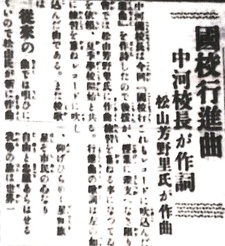 “‘Japanese School March,’ the lyrics written by principal Nakagawa” (The North American Times, July 12, 1938)
“‘Japanese School March,’ the lyrics written by principal Nakagawa” (The North American Times, July 12, 1938)Principal Yoriaki Nakagawa wrote the lyrics to the “Japanese School March,” so the writing of music was requested of Yoshinori Matsuyama at the gathering of supporters. They began practicing at the start of summer school and recorded it…. The lyrics of the march are on the left.
“Looking up to the fluttering star-spangled banner
The stars that show the freedom and loyalty of citizens at the heart
Our flag that sits at the top of the world.”
According to some sources, the school took advantage of the opportunity of composer Matsuyama visiting the school.2 They asked him to add music to the lyrics and he also gave some vocal lessons. Students became familiar with this march, and it was sung many times at graduation ceremonies and on Sports Days (athletic meets).
In the October 14, 1938 issue, the The North American Times reported that the Japanese School March was spiritedly sung at the Japanese School Arts Festival.
JAPANESE SCHOOL SPORTS DAY
The Sports Day that was held every summer was a big event that almost all Japanese residents in Seattle participated in.
“Sports Day at a Japanese School” (May 31, 1938 issue)
Under a rainy sky that cleared right before lunchtime, the Japanese School held its Sports Day on this past 29th, starting at 11 a.m. at Jefferson Park, with the dignified sound of a horn giving the opening cue. They finished all races of students up to fifth grade and also had various activities after lunch, such as hikouki-otoshi (dropping airplanes), Olympic relays, games and choral singing. The day was closed by the principal’s speech at 5 p.m. It was a chilly day with wind and rain, but the playground was filled with parents. (The photo taken by Karwin — The parents of students watching races.)
We can see that although studying under the strict environment of American public schools and learning Japanese at Japanese school(s), the Nisei worked hard, obtaining educations that would later help them guide the post-war Nikkei community in Seattle.
The Seattle Japanese Language School continues today, in its original buildings, as a program within the larger-missioned Japanese Cultural & Community Center of Washington. The community center is used by many today as a place to learn and share Japanese culture.
In the next chapter, I will introduce articles addressing the issue of dual citizenship of Nisei as well as their marriages.
Note:
1. All article excerpts are from The North American Times unless noted otherwise.
2. See Greg Robinson, “Yoshinori Matsuyama: A Transnational Japanese Tenor and Composer in America” on Discover Nikkei.
References
Edited by Tokyo City Board of Education “American Education in the Eyes of Elementary School Principals” 1920
Hokubei nenkan, Hokubei jijisha, 1928, 1936
Edited by The Committee of Japanese in America for Preserving Historical Events “History of Japanese in America” Zaibei-nihonjin-so, 1940
Compiled under the supervision of Eisaburo Okuizumi “Japanese Textbook 1920-30 Seattle Edition” Bunsei Shoin Co., 2012
*The English version of this series is a collaboration between Discover Nikkei and The North American Post, Seattle’s bilingual community newspaper. This article was originally publishd on March 14 and April 18, 2023 in The North American Post and is modified for Discover Nikkei.
© 2022 Ikuo Shinmasu


